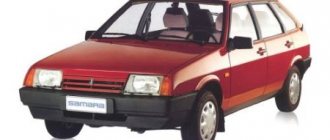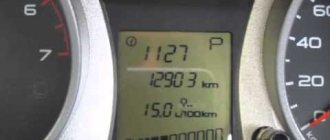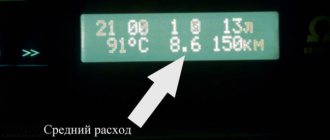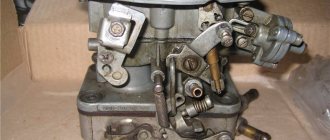Fuel consumption VAZ 2106 1.3l.
The VAZ 2106 was equipped with a five-speed gearbox and a gasoline carburetor engine with a displacement of 1300 cc. and power 64 hp. The car has a top speed of 145 km/h and accelerates from zero to hundreds in 18 minutes. Fuel consumption within the city is 9.5 liters, and on the highway – 7.6-8 liters per hundred kilometers.
Real fuel consumption of VAZ 2106 1.3l.
- Andrey. Kirov. I inherited a VAZ 2106 produced in 1992 from my father. This was five years ago. Of course, at that time there were practically no “original” spare parts in the car, but the engine worked “like a clock” and never let me down. If you don’t press the gas pedal to the floor on the highway and warm up the car thoroughly in winter, then there will be no problems with it. I think that a domestically assembled engine, with proper and timely maintenance, will last for many more decades. As for fuel consumption, my 1.3 liter engine “eats” about ten liters in the city, and on the highway – within seven liters per hundred.
- Oleg. Tomsk I bought a VAZ 2106 from a neighbor in 2005 with a 1.3-liter engine. The car came off the assembly line back in 1988, so you understand that its condition was not the best. I overhauled the engine, replaced all consumables, slightly modernized the interior and drove it without problems for five years. I was also completely satisfied with fuel consumption: in the city no more than ten liters, and on the highway during normal driving it was possible to keep within 7.5-8 liters.
- Sergey. Adler. I bought a VAZ 2106 from 1985 specifically for taxi work. The previous owner loved his car, so I got it in very good condition. I drove the “Six” for almost seven years and during this time it did not create any special problems for me. If we talk about fuel consumption, then I got about ten liters in the city and eight on the highway.
- Vladimir. Kazan. The VAZ 2106 with a 1.3-liter engine is a good domestic car that, with proper care, can faithfully serve for several decades. I bought my ’85 “six” in 2001 in order to take my family to the dacha and visit relatives. In addition, I also drove the car for work, so it rarely came into my garage. During the entire period of operation, I never looked into the engine, since there was no need for this, it worked properly and did not let me down. In terms of fuel consumption: in the city with normal traffic it was up to ten liters, and on the highway - 8-8.5 liters per hundred.
- Alexei. Ulyanovsk VAZ 2106 1.3 liter - this is my first car. I bought it new off the production line in 2001 and drove it for almost ten years. Of course, immediately after the purchase I had to tighten up a few things and blow out the bottom, but otherwise I had no complaints about the car. The machine is a real “workhorse”; I have no doubts about this during the entire time I used it. In terms of consumption, I can say the following: in the city I got from eight to ten liters, and on the highway (if I didn’t press the accelerator pedal to the floor) - 8-8.5 liters per hundred kilometers.
Fuel consumption of VAZ 2103, 21033, 21035, 2106, 21061, 21063, 21065-00, 21065-01 cars
Fuel consumption measurements were carried out on rear-wheel drive VAZ 2103, 21033, 21035, 2106, 21061, 21063, 21065-00, 21065-01. At the time of measurement, the vehicle mileage did not exceed 30,000 km. All of them were in technically sound condition. Measurements along the highway were carried out on sections of roads with an average height difference, in the city with average traffic intensity. The cars were fully loaded - four people (including the driver) in the cabin and 40 kg of cargo in the trunk. The time to measure fuel consumption is mid-autumn. Gasoline - AI-92.
Fuel consumption of VAZ 2103, 21033, 21035, 2106, 21061, 21063, 21065-00, 21065-01 cars
VAZ 2103
Engine 2103, 54.1 kW/73.5 hp, volume – 1.45 l, four-speed gearbox.
Highway – 90 km/h – 7.7 l/100 km
120 km/h – 10.7 l/100 km
City – 11.9 l/100 km
VAZ 21033
Engine 21011, 2105, 48.3 kW/65.7 hp, volume – 1.3 l, four-speed gearbox.
Highway – 90 km/h – 7.6 l/100 km
120 km/h – 10.5 l/100 km
City – 10.8 l/100 km
VAZ 21035
Engine 2101, 48.3 kW/65.7 hp, volume – 1.2 l, four-speed gearbox.
Highway – 90 km/h – 7.6 l/100 km
120 km/h – 10.0 l/100 km
City – 10.8 l/100 km
VAZ 2106
Engine 2106, 56.3 kW/76.4 hp, volume – 1.57 l, four-speed gearbox.
Highway – 90 km/h – 7.4 l/100 km
120 km/h – 10.1 l/100 km
City – 10.3 l/100 km
VAZ 21065-00
Engine 2106, 56.3 kW/76.4 hp, volume – 1.57 l, five-speed gearbox.
Highway – 90 km/h – 7.1 l/100 km
Fuel consumption VAZ 2106 1.5l.
VAZ 2106 1.5. It was equipped with a gasoline carburetor engine and a five-speed manual transmission. The engine displacement is 1452 cc and power is 72 hp. Engine torque is 104 Nm at 3400 rpm. The car has a top speed of 150 km/h and accelerates from zero to hundreds in 17 seconds. Fuel consumption VAZ 2106 1.5l. in the city it is 9.8 liters, on the highway - 7.4 liters per hundred kilometers.
Other cars: BMW X5 fuel consumption reviews
Real fuel consumption of VAZ 2106 1.5l.
- Vladislav. Samara. Six years ago I bought a second-hand “six” with a one and a half liter engine for work and I drive it to this day. What can I say, in my opinion, this is the best car for our roads. In addition, considering that the car rolled off the assembly line back in 1988, its condition can be said to be ideal. If your head “cooks” and your hands grow from the right place, then you can use the “six” for more than a dozen years. In terms of gasoline consumption, my average is ten liters in the city and up to 8.5 on the highway.
- Dmitriy. Kazan. My “swallow”, after a major overhaul in 2001, still doesn’t drive, but flies! I completely overhauled the engine and gearbox, changed all the consumables and slightly modernized the interior. Since then there have been no major problems. In terms of gasoline consumption, I get about ten liters when driving around the city and no more than nine on the highway.
- Egor. Samara. I inherited my “six” with a one and a half liter engine from my father in 1995. My father loved the car very much and looked after it carefully. The machine served me faithfully for ten years, after which I sold it. It seems to me that for our expensive VAZ 2106 it is exactly what we need. The machine is stable, durable, convenient, and most importantly, not expensive to maintain. In terms of gasoline consumption, I got no more than 10 liters in the city (in normal traffic) and up to nine liters on the highway.
- Ivan. Saint Petersburg. I bought the car off the production line in 1993. Of course, for greater comfort and safety I had to tighten some parts and blow out the bottom, but otherwise I was completely satisfied with the car. Playful, easy to control and stable. In addition, the suspension is not very stiff, and the interior is spacious and comfortable. I sold my “six” five years ago and today I already regret it. The car “eats” relatively little, and maintenance costs pennies. My gasoline consumption averaged up to 10 liters within the city and 7.5-8 liters on the highway, which I think is quite normal.
- Victor. Kostroma. I bought a used 1993 Six from a work colleague. What can I say, the car is a real classic of the domestic automobile industry. A spirited engine, a relatively soft suspension, a comfortable interior that warms up quickly in winter. In addition, if the hands grow from the right place, then maintenance costs mere pennies. Fuel consumption is also within normal limits: in the city up to ten liters, and on the highway (if you don’t drive) you can keep within 7.5-8 liters per hundred kilometers.
- Nikita. Moscow. I bought a “six” second hand after a major overhaul. At that time, it already had 7,000 kilometers on it. Today the mileage is 25,000 km, and I still have no complaints about the machine. It picks up speed quickly, has good stability and controllability, and most importantly, is inexpensive to maintain. In terms of gasoline consumption, everything also suits me: in the city with heavy traffic it turns out to be up to ten liters, and on the highway with normal driving you can keep within 8 liters.
- Victor. Stavropol. It seems to me that the “six” with a one and a half liter engine is an ideal car for those who are just acquiring driving skills and are trying to figure out how everything works in the engine, gearbox, etc. The car is easy to control, stable and playful. I’ve been riding mine for five years now and I don’t have any particular complaints, although I bought it used. Gasoline consumption is also within normal limits: in the city I get no more than ten liters, and on the highway, if I don’t drive, it’s 7.5-8 liters.
- Natalia. Belgorod. My husband bought a VAZ 2106 from 1988 from a friend. He said that this is an ideal option for acquiring driving skills. And today I understand that he spoke the truth. We made a capital investment immediately after the purchase, and to this day we have no complaints about the machine. Of course, this is not a foreign car with climate control and leather seats, but the car is quite enough for everyday movement around the city. In terms of gasoline, I get about ten liters in the city and 8-8.5 on the highway.
Other cars: Nissan Sunny fuel consumption owner reviews
VAZ 2104
The model, created as a station wagon based on the VAZ 2102, has long been considered the cheapest station wagon among all cars sold on domestic car markets. The popularity of the 2104 lay in the fact that it was assembled from simple parts, and that spare parts for it were always easy to find. The model was produced at the factory from 1984 to 2012. During its production, the VAZ 2104 was equipped with one of four options for gasoline engines or a diesel power unit.
| Engine | Consumption (city) | Consumption (highway) | Flow (mixed) | Type of fuel |
| 1.3 MT 64 hp | 10.0 | 5.8 | 7.4 | Petrol |
| 1.5 MT 75 hp | 10.2 | 7.4 | 9.0 | |
| 1.6 MT 74 hp | 9.5 | 6.8 | 9.2 | |
| 1.7 MT 79 hp | 9.5 | 7.2 | 8.2 | |
| 1.5 MT 50 hp | 5.7 | 5.8 | 5.8 | Diesel |
Fuel consumption VAZ 2106 1.6
VAZ 2106 1.6. with a manual five-speed gearbox, equipped with a gasoline carburetor engine with a working volume of 1569 cc and a power of 75 hp. Maximum torque Nm at rpm – 116/3000. The maximum speed of the car is 155 km/h. acceleration from zero to hundreds is carried out in 16 seconds. Fuel consumption: city - 10.3 liters, highway - 7.4 liters per hundred kilometers.
Real fuel consumption of VAZ 2106 1.6l.
- Sergey. VAZ 2106 produced in 1976 is my first car. What can I say, the car is not bad, but it came to me in terrible condition. I made a capital investment, after which I rode it for another seven years. During this time there were no special complaints. If breakdowns did occur, in most cases they were able to be fixed independently with minimal investment. In terms of consumption after repair, it turned out exactly as stated in the passport - no more than 7.5 liters on the highway and a little more than ten in the city.
- Eugene. Astrakhan. I bought a six with a 1.6-liter engine from a neighbor a couple of years ago. The previous owner's car sat in the garage for a long time, so I had to tinker with it. Despite the fact that the car came off the assembly line back in 1984, it is in good condition. Now I also want to repaint the body and install new seats for greater comfort, and I can still ride for at least a hundred years!))) In terms of gasoline consumption, I can say the following: in the city 10-11 liters, on the highway no more than 8.5 liters per hundred.
- Valery. Kostroma. I recently bought a six with a 1.6 engine from a friend. I can only say one thing: you shouldn’t buy such a car after driving a foreign car for several years. On my first trip I almost went crazy! At a speed of 70-80 km/h, everything in the cabin begins to creak and rattle, and when accelerating to 120, it throws the car from side to side. Of course, taking into account the age of the car (1979), you can make a discount, but still... In terms of fuel consumption, of course, everything is more than good: in the city - a little more than ten liters, and on the highway during normal driving you can keep within 8 liters.
- Nikolai. Kaluga. My father gave me a VAZ 2106. This was my first car, which I could not get enough of. I rode an “old lady” made in 1979 for almost seven years and I can say with confidence that this is an ideal vehicle for those who want not only to gain driving skills, but also to understand what and how it works in a car. For gasoline, I got no more than ten liters in the combined cycle.
- Marina. Kazan. My husband gave me a VAZ 2106 from 2000. What can I say: the car is excellent, easy to control and playful. In addition, even the most complex repairs are not expensive, which is also nice. My gasoline consumption is as accurate as it is stated in my passport: 7.4 liters on the highway and 10.3 in the city.
- Denis. Krasnodar. I took a VAZ 2106 produced in 1999 for work. I do repairs and constantly travel to customers, both around the city and beyond. The car suits me perfectly. It is easy to control, stable, with a relatively soft suspension. In addition, even when I load the roof rack with building materials, the speed also develops quite quickly and it pulls well downhill. In terms of gasoline consumption: in the city with normal traffic it turns out to be 10-11 liters, and on the highway, if you don’t drive, you can keep within 7.5-8 liters.
- Oleg. Khabarovsk. The main advantage of the VAZ 2106, as for me, is the ease of repair and maintenance. If the hands grow from the right place, then repairs generally cost pennies. I’ve been driving my “six” for ten years now and I have no complaints about this “workhorse”. Fuel consumption also suits me: in the city I spend a little more than ten liters, and on the highway I get within eight.
- Peter. Rostov-on-Don. My “six” served me faithfully for fifteen years. This car was created for our roads and there can be no doubt about it. Over the entire period of operation, I, of course, replaced the bulk of the “original” spare parts and once made a major overhaul of the engine. But even so, maintenance over the entire fifteen years cost me mere pennies. As for fuel consumption, my “swallow” “ate” about 10.-11 liters in the city and up to eight on the highway.
- Maksim. Chelyabinsk. My father bought a VAZ 2106 2000 from the factory. Of course, I immediately had to go to the service station to tighten the bolts where necessary and blow out the bottom. Otherwise, my father was completely satisfied with the car and drove it for ten years, after which he gave it to me. I want to say this: if you take care of the car, carry out repairs and maintenance on time and drive carefully, then the VAZ 2106 will last at least a hundred years. In terms of gasoline, even today I get it practically, as it is written in my passport: 10.5 -11 liters in the city and 7.5-8.5 on the highway.
- Konstantin. Vladimir. I bought a VAZ 2106 with a 1.6-liter engine to work in a taxi service. I am completely satisfied with the car. The engine works properly, even in severe frosts the car starts with half a turn, repairs and maintenance are not expensive, and gasoline consumption does not exceed the figures specified in the documents: 10.5 liters in the city and 7.5 liters when driving on the highway.
Other cars: Peugeot 406 fuel consumption
Operation and gasoline consumption
The reasons for the high gasoline consumption of the VAZ-2106 also lie in operation. An aggressive driving style is not designed for economy. Sharp accelerations lead to significant waste of fuel.
To save money, you should switch to a calm style - with smooth presses on the gas pedal, approaching traffic lights in neutral, and performing maneuvers only when absolutely necessary.
You should also choose the right load on the engine, do not give increased speed, but run the engine a little “pull”.
It has been established that the speed of the VAZ-2106 power plant, at which the flow rate is most optimal, is in the range of 3000-5000 rpm. If you stick to this range as much as possible when driving, you will be able to reduce consumption, and significantly - up to 25%.
Music lovers will have to choose between music and gas mileage, especially for those who use significant audio equipment (subwoofer, large number of speakers). Heavy load on the on-board network affects consumption.
Therefore, to save money while traveling, you should reduce the use of electrical appliances to the maximum (use only the most necessary - headlights, light and sound alarms).
Excess weight in a car means grams of fuel. Therefore, it is worth taking out the unnecessary things from the car and leaving the really useful things - tools, spare tire, etc.
Windows open while driving become a wind tunnel. That is, the air flow enters the cabin at high speed, thereby resisting movement. And the more the windows are open, the stronger the effect of the oncoming flow. Naturally, in the summer it is impossible to drive in a completely closed car (especially since there is no air conditioning in the VAZ-2106), but still, to save money, it is worth using the interior ventilation system (open deflectors), which, in general, are not very useful in the heat, but If you open the windows, then not all and not completely.
All these recommendations will not work a miracle, but they will not only allow you to return gasoline consumption to the established standard values, but also reduce it slightly (in some cases it is possible to reduce consumption to 6 liters on the highway).
Finally, we note that consumption is affected not only by the technical condition and operating features. Savings also largely depend on the fuel itself. If it is of poor quality and contains impurities, then much more of it will be consumed (it will not be able to burn fully, hence the drop in power and the need to press the gas pedal more to obtain the necessary driving dynamics). Therefore, refueling with high-quality fuel, even if it is a little more expensive, ultimately results in savings.
Fuel consumption of VAZ 2106 with gas equipment
- Vlad. Ekaterinburg. I have a VAZ 2106 1.5 on gas. I had already come across gas equipment for cars before, so I installed it myself at minimal cost. I am completely satisfied with the car both in operation and maintenance. After switching to gas, fuel costs decreased several times, which I am very pleased with. I get about 8.5 liters on the highway and 10-11 when driving around the city.
- Semyon. Pskov. I bought a VAZ 2106 1.3 to work in a taxi service. Despite the fact that the car is over twenty years old, it drives normally, and serious breakdowns are extremely rare. I recently switched to gas and my fuel costs immediately dropped noticeably. During normal driving on the highway I get 8-9 liters, and within the city – 10.5-11 liters per hundred kilometers.
- Alexander. Nizhny Novgorod. I bought a “six” with a one and a half liter engine from a friend and immediately decided to install gas equipment on it. Of course, during the entire period of operation (8 years), I replaced almost all the “original” spare parts, and also repainted the body. There are no special complaints about the car. The car is maneuverable, playful and durable. In terms of gas consumption, I get about 10-11 liters in the city and no more than 8.5 when driving on the highway.
- Stas. Peter. I inherited the “Six” from my grandfather. Grandfather had not driven his car for more than three years, so he had to go through almost everything in it and also repaint the body. To save more fuel, I bought a gas installation, which the guys at the service station installed in just a few minutes. I can say this: if you take care of the car, change consumables and oil on time, then it will “run” for more than one thousand kilometers without serious breakdowns. Today my consumption is no more than 11 liters in mixed mode.
- Basil. Lipetsk. I provide plumbing services, so I simply cannot do without a car. I was looking for a cheap car with low fuel consumption and a friend advised me to buy a VAZ 2106 with a gas installation. I bought a car in excellent condition, right after a major overhaul. I’ve been riding for four years now and have no complaints about my “old lady”. I replace consumables and minor repairs myself, so the cost of maintaining the car is minimal. My gas consumption is low: up to nine liters on the highway and no more than 11 liters in the city.
- Kirill. Ufa. I bought a “six” with a one and a half liter gas engine and in five years I have not regretted it even once. The machine is simply a “workhorse”! I constantly go on long-distance business trips and don’t worry about getting seriously damaged on the highway. If you take care of the car and use it carefully, it will faithfully serve for many decades and will “outlast” most modern foreign cars. With a gas installation, my consumption is within 11 liters in the city and 8-9 on the highway.
VAZ 2113
The production of this three-door hatchback, which contains basic elements of the VAZ 2108 and VAZ 2115, began in 2004 and was produced until 2014, being removed from the assembly line only after the appearance of more modern models. The cars of this series were equipped with gasoline engines with fuel injection, which worked in conjunction with a five-speed manual transmission.
| Engine | Consumption (city) | Consumption (highway) | Flow (mixed) | Type of fuel |
| 1.5 MT 79 hp | 9.2 | 7.6 | 8.4 | Petrol |
| 1.6 MT 81 hp | 10.0 | 5.7 | 7.6 | |
| 1.6 MT 98 hp | 9.8 | 5.2 | 7.4 |
Diagnosis and resolution of technical problems
A serious increase in fuel consumption never occurs without reason. The “culprit” is often detected by the following signs:
- drop in engine power, noticeable deterioration in traction and acceleration dynamics;
- the appearance of the smell of gasoline in the car interior;
- idle failure;
- jerks and dips during movement;
- the engine suddenly stalls while driving;
- at idle, the crankshaft speed “floats”;
- The smell of burnt pads and noise from increased friction can be heard from the wheels.
The listed symptoms may indicate one or more technical problems. To save fuel, learn to quickly recognize the source of a malfunction and promptly fix the problem - yourself or at a service station.
Cylinder piston and valve group
Natural wear of pistons and rings causes the following consequences:
- A gap is formed between the walls of the cylinders and pistons, into which gases from the combustion chamber penetrate. Passing through the crankcase, exhaust gases are sent through the ventilation system for afterburning, contaminating the carburetor air jets and excessively enriching the fuel mixture.
Gases penetrate through the gap around the worn piston, and the compression of the combustible mixture deteriorates. - Compression drops and gasoline combustion conditions worsen. To develop the required power, the engine begins to consume more fuel, and the lion's share of unburned fuel is thrown out through the exhaust tract.
- Motor oil penetrates into the combustion chambers, aggravating the situation. A layer of carbon deposits on the walls and electrodes causes overheating of the cylinder head.
Critical wear of the cylinder-piston group increases fuel consumption by 20-40%. Valve burnout leads to complete failure of the cylinder and an increase in flow rate by 25%. When 2 cylinders are switched off in a VAZ 2106 engine, gasoline losses reach 50%, and the car practically “does not move.”
While repairing Zhiguli cars, I repeatedly came across cars that arrived on two cylinders - the rest were “dead”. The owners complained about the lack of power and the colossal gas consumption. Diagnostics always revealed 2 reasons - burnt-out valves or failure of the spark plug.
A burnt-out valve allows gases to pass in both directions, the pressure drops to zero and the cylinder completely fails.
How to check the motor for wear:
- Pay attention to the color of the exhaust - oil fumes produce thick bluish smoke.
- Disconnect the crankcase ventilation pipe from the air filter housing and start the engine. If the compression rings are worn out, a bluish exhaust will come out of the hose.
- Measure compression in all cylinders while hot. The minimum acceptable value is 8.5-9 Bar.
- If the pressure gauge shows 1-3 bar pressure in the cylinder, the valve (or several valves) has become unusable.
Thick, bluish-colored exhaust indicates waste of engine oil and wear of the piston group.
To finally make sure that the valve is burned out, pour 10 ml of motor lubricant inside the cylinder and repeat the compression measurement. If the pressure rises, change the rings and pistons; if the pressure remains unchanged, throw away the valves.
Zero readings on the pressure gauge indicate a leak in the cylinder due to a burnt-out valve.
The wear of elements and the “gluttony” of the engine can be treated in the only way - major repairs and replacement of unusable parts. The final verdict is made after disassembling the power unit - perhaps it will be possible to save money by changing only the valves and rings.
Video: how to measure compression in cylinders of a VAZ 2106
Fuel supply system
Problems in this group cause excess fuel consumption of 10-30%, depending on the specific problem. The most common breakdowns:
- increased fuel level in the carburetor float chamber;
- clogging of air jets (one of the reasons is stated above);
- abrasion of the throttle valves - gaps form at the edges, from where the engine sucks in fuel due to vacuum;
- unqualified carburetor adjustment - violation of the settings of the support and fuel screws;
- air leaks on the intake manifold flange or on the throttle valve axles;
- breakthrough of the lower diaphragm of the fuel pump.
If the car interior smells like gasoline: https://bumper.guru/klassicheskie-modeli-vaz/poleznoe/zapah-benzina-v-salone.html
The last malfunction is the most insidious. The pump pumps fuel in 2 directions - to the carburetor and into the engine crankcase through the drive rod. The oil dilutes, the pressure drops, gasoline vapors fill the intake manifold and greatly enrich the mixture, consumption increases by 10-15%. How to detect: remove the breather tube with the engine running and carefully sniff the gases. A strong smell of fuel will immediately indicate a malfunction.
If there is gasoline in the crankcase, smoke with a pungent odor will come out of the removed pipe.
I check the excessive consumption of gasoline by the carburetor this way: I remove the air filter housing, start the engine and look inside the diffuser of the primary chamber. If the unit “overflows”, drops from the sprayer fall on the damper from above, the engine immediately reacts with a jump in speed. When the excess fuel is burned, the idle speed returns to normal until the next drop falls.
Another way to check the carburetor is to tighten the “quality” screw with the engine running. Turn the regulator with a screwdriver and count the revolutions - at the end the engine should stall. If the power unit continues to operate with the screw tightened, it means that fuel enters the manifold directly. The carburetor must be removed, cleaned and adjusted.
If the “six” engine stalls safely, turn the screw back to the calculated number of revolutions
Do not try to save money by replacing standard carburetor jets with parts with a smaller flow area. The fuel mixture will become lean, the car will lose dynamics and power. You will increase your consumption yourself - you will begin to press the accelerator pedal more intensely.
Another problem lies in the jets sold as part of repair kits for Ozone carburetors. Along with the broken diaphragms, the owners install new jets - beautiful and shiny. Having special measuring gauges, I threw away a lot of this beauty for one reason: the diameter of the passage hole does not correspond to the inscription (as a rule, the cross-section is made larger). Never change standard jets - their real service life is 20-30 years.
Replacing the fuel pump membrane is not difficult:
- Disconnect the fuel hoses.
- Unscrew the 2 fastening nuts with a 13 mm wrench.
The Zhiguli fuel pump is screwed to the flange on the left side of the engine (in the direction of travel) - Remove the pump from the studs and unscrew the housing with a screwdriver.
- Install 3 new membranes, assemble the unit and attach it to the motor flange, replacing the cardboard gasket.
The VAZ 2106 gasoline pump has 3 membranes, they are always changed together
If the fuel pump has been pumping fuel into the crankcase for a long time, be sure to change the oil. I am familiar with cases when, in the summer, due to diluted lubricant, the crankshaft turned the plain bearings (otherwise known as bearings). Repairs are quite expensive - you need to buy new repair liners and grind the crankshaft journals.
Video: setting up the Ozone carburetor
Ignition elements
Problems in the spark generation system also cause the power unit to consume excess fuel. Example: due to misfire, a portion of the combustible mixture drawn by the piston into the combustion chamber completely flies out into the pipe during the next cycle. There was no flash, no work was done, gasoline was wasted.
Common ignition system problems that cause excessive fuel consumption:
- Failure of a spark plug leads to cylinder failure - plus 25% to fuel consumption.
- A breakdown of the insulation of high-voltage wires reduces the power of the spark, and the air-fuel mixture does not burn completely. The residues are pushed into the exhaust system manifold, where they can burn out without any benefit to the engine (popping noises are heard in the pipe).
- Sparking worsens due to malfunctions of the distributor parts - breakdown of the cover, burnout of the contact group, bearing wear.
The mechanical contact group must be periodically cleaned and the gap adjusted to 0.4 mm - When the membrane of the vacuum unit becomes unusable or the springs of the centrifugal regulator weaken, the ignition timing decreases. The spark is supplied late, engine power drops, and fuel consumption increases by 5-10%.
I find the non-working candle to be the old “grandfather’s” method. I start the engine, put on a dielectric glove and one by one remove the cradles from the spark plug contacts. If the crankshaft speed drops at the moment of shutdown, the element is in good condition, I move on to the next cylinder.
You should not remove the armor wire with your bare hands - put on a glove or use pliers
The best diagnostic method for an inexperienced driver is to replace the distributor or high-voltage cables. If there is no spare distributor in the garage, clean or change the contact group - the spare part is inexpensive. Bearing play is checked manually by rocking the turntable up and down. Diagnose the integrity of the vacuum unit membrane by drawing air through the tube leading to the carburetor.
How to reduce gasoline consumption VAZ-2106: profitable saving options
Gasoline today is not cheap, so it is natural that car owners strive to reduce its consumption.
Here are some smart and effective ways to save fuel:
- One of the most effective options is to install gas equipment. Propane and methane are cheaper than gasoline.
- Change your driving style. In the city you can drive at a speed of 60 km/h, and on the highway – 90 km/h. You should forget about sudden acceleration and braking. As a rule, this helps reduce fuel consumption by 40%.
- Installing a pneumatic drive on a carburetor.
- Installation of a 5-speed gearbox.
- Use light motor oils. It is advisable to use oils with low viscosity, as they save fuel by 6%.
- Check tire pressure periodically. If the ramps are underinflated, they increase rolling resistance, which, in turn, significantly consumes fuel. Please note that the check can only be carried out with cold tires.
- Maintain approximately the same speed, even in traffic jams. As we said, you shouldn't brake and start hard if you want to reduce fuel consumption.
- Use the pedal carefully. A sudden start consumes a lot of fuel, so you need to start the car slowly.
- Rarely turn on the air conditioner. This device burns from 5 to 20% gasoline.
- Get rid of anything that increases air resistance. This is mainly due to tuning, extra things in the trunk, cargo on the roof, etc. It is also advisable not to change the serial wheels to wide ones.
The following actions will also help save fuel consumption:
- Only when absolutely necessary should you use power windows, heated rear windows and interior lighting. By and large, these devices are rarely needed, so their use can be reduced;
- replace contact ignition with electronic one. In most cases, this helps reduce fuel consumption;
- troubleshoot problems in the ignition system in a timely manner. Approximately 30-40% of fuel can be lost if the ignition system operates intermittently;
- Do not brake suddenly. In particular, this applies to carburetor cars, because during sudden braking, a large amount of fuel is sucked through the jets.
So, we looked at the most effective and popular ways to save gasoline. If you are used to driving at high speeds, you will have to forget about this in order to save money. It is also important to follow a number of other rules in order to reduce fuel consumption in your car. It is very important to act without fanaticism, otherwise saving will not lead to anything good.
Reasons for increased fuel consumption
Many VAZ 2106 owners have encountered such a problem as increased fuel consumption, but not everyone knows what affects the engine’s appetite. And how to reduce consumption. Below in this article I will try to describe all those points that in one way or another negatively affect fuel consumption. And also the main ways to eliminate these problems. I’ll immediately make a reservation that everything described below took place in my personal experience, so I would not call this list complete.
Fuel quality and octane number
I think many people have noticed that depending on the place of refueling, your VAZ 2106 always consumes gasoline differently. If this has not been noticed, it means you haven’t been driving long enough yet. Everyone encounters low-quality gasoline in one way or another. Another question is how to protect yourself from this?
Well, it’s difficult to give any sensible advice here. Unless you try, if possible, to refuel only in trusted places. But even there, there is outright slag! If you feel that there is surrogate in the tank, then ideally you need to drain all this muck. Well, then refuel with normal fuel. Otherwise, you risk damaging the engine.
Regarding the octane number. Here you should follow the manufacturer’s recommendations and fill in the gasoline that your engine requires. If it says 92, it means we only use it if we want normal consumption.
Condition of the internal combustion engine and fuel system and increased fuel consumption
If the engine of your VAZ 2106 is already pretty tired, and the mileage without repair is already hundreds of thousands of kilometers, then it is possible that the reason for the increased fuel consumption is precisely the loss of engine power. And moreover, it begins to consume excessively not only gasoline, but also oil.
In this case, only engine repair will help solve this problem:
- replacing piston rings,
- boring cylinders if necessary
- replacing the pistons themselves.
Regarding the fuel system. Likewise, it must be in excellent condition so that consumption remains normal. The carburetor should not “flood” or over-supply fuel at idle speed. Adjust the carburetor if necessary.
If you have an injection engine, then the increased fuel consumption may depend on even more factors. Example. The failure of one of the ECM sensors almost always entails an increase in the appetite of your car. This is especially true for sensors such as:
- Mass air flow sensor - mass air flow sensor,
- TPS - throttle position sensor,
- IAC - idle speed controller and others.
Weak or uneven tire pressure on VAZ 2106
If you notice that the car begins to pull to the side, then you should first of all pay attention to the tire pressure. If one of the wheels is “weak”, then even this factor will negatively affect fuel consumption. And low pressure in all tires can lead to a serious increase in appetite.
It is advisable to periodically check each car wheel with a pressure gauge. It is especially important to do this before every long trip.
Increased fuel consumption. Road and weather conditions
It happens quite often that increased fuel consumption is inevitable. Since it directly depends on road or weather conditions.
Example. If you are driving on a dry road without noticeable wind resistance, then naturally your car’s gas consumption will be within normal limits. In rain and strong winds, the fuel level can decrease much faster. There is no way around this, unless you don’t operate the car in such conditions.
Also, don’t discount the time of year. I think there is no need to explain that in winter the fuel gauge needle approaches zero much faster than in summer. The reason is not only poor road conditions, but also the daily warming up of the engine. We waste a lot of gasoline on this.
Vehicle load and operation with a trailer
There was no need to write about this at all. Since it should be clear to everyone that the greater the load on the car, the more power the engine will have to spend. And accordingly, much more fuel will be consumed. This is especially noticeable when operating with a trailer, so you should pay attention to this too!
Of course, there are still many factors that can negatively affect the increased fuel consumption of the VAZ 2106. And if you want to add to this list, then you can easily share your opinion in the comments below!
What is the fuel consumption of the Lada and how to reduce it
For Lada, like other cars, the average fuel consumption of the VAZ 21061 on the highway is about a quarter more than in the city. Such features are due to the fact that on the highway cars quickly adapt to speed, stable driving, without sudden braking and other things.
| Model | Consumption (highway) | Consumption (city) | Consumption (mixed cycle) |
| VAZ 2106 | 8.0 l/100 km | 11 l/100 km | 9 l/100 km |
It is worth saying that car maintenance now is not cheap, and therefore many motorists are thinking about how to reduce fuel consumption on a VAZ 2106? This question has remained relevant since the time when the first car appeared. For a long time, drivers have come up with a lot of ways, and yet, they were able to find several that work. Before moving on to them, you should understand that saving is not a modification of your car, but rather a change in your behavior and driving habits.
Several ways to reduce car fuel consumption
- Change the way you drive your car, don’t try to push it to the maximum. The manners of a real driver are characterized by: smoothness, accuracy, absence of sudden braking and starting. Using a VAZ at medium engine speeds is the most effective way to save gasoline.
- Correct all breakdowns in a timely manner. Any damage to the car provokes an increase in fuel consumption, which is not savings. Ultimately, a minor malfunction can lead to a number of problems, and then you will have to empty your piggy bank completely! Speaking about the fuel consumption of the VAZ 2106, this car simply brutally consumes its fuel reserve when it breaks down.
- Don't skimp on the quality of gasoline. Low-quality gasoline will not allow the “horse” to work well; it will clog the existing filters, which will not only reduce the machine’s power significantly, but will also lead to a lot of breakdowns in the future. Unfortunately, such savings often become the cause of malfunctions.
- When choosing a car, you should consider what class of car you are able to service efficiently and quickly; initially, you should not consider any car. Give preference to those cars in which you are completely confident, because your “horse” should run and not sit in the garage. If you can’t afford a car with high fuel consumption, give preference to small cars!
- The last method is the most dangerous for your car unless you are a professional or a mechanic. Tuning the carburetor allows you to reduce fuel consumption, but at the same time you need to be prepared for the fact that the performance of the VAZ may also decrease.
VAZ 2131
This car is better known as Niva 2131. Initially, such cars, built on the basis of the Niva 2121, but with a longer body, were intended for export. But due to their good cross-country ability and relatively low price, they have gained popularity in the domestic market. Production of the VAZ 2131 started in 1993 and continued until 2021, when it was replaced by a newer version, the Lada 4×4 Urban. The VAZ 2131 was equipped with one of five gasoline engines or a diesel power unit.
| Engine | Consumption (city) | Consumption (highway) | Flow (mixed) | Type of fuel |
| 1.7 MT 79 hp | 13.7 | 9.8 | 12.0 | Petrol |
| 1.7 MT 80 hp | 13.7 | 9.8 | 12.0 | |
| 1.7 MT 83 hp | 13.7 | 9.8 | 12.0 | |
| 1.8 MT 82 hp | 13.8 | 12.0 | 13.2 | |
| 1.8 MT 84 hp | 13.8 | 12.0 | 13.2 | |
| 1.9 MT 50 hp | 9.7 | 6.8 | 7.6 | Diesel |
The actual fuel consumption of VAZ models per 100 km may differ from the standard data specified in the tables, and it can only be determined experimentally. It is important to remember that average fuel consumption can differ significantly in winter and summer. If fuel consumption is much higher than the average values given in the tables, the car must be taken to a mechanic service station and, after determining all the factors of increased consumption, it may be worth switching it to gas.











